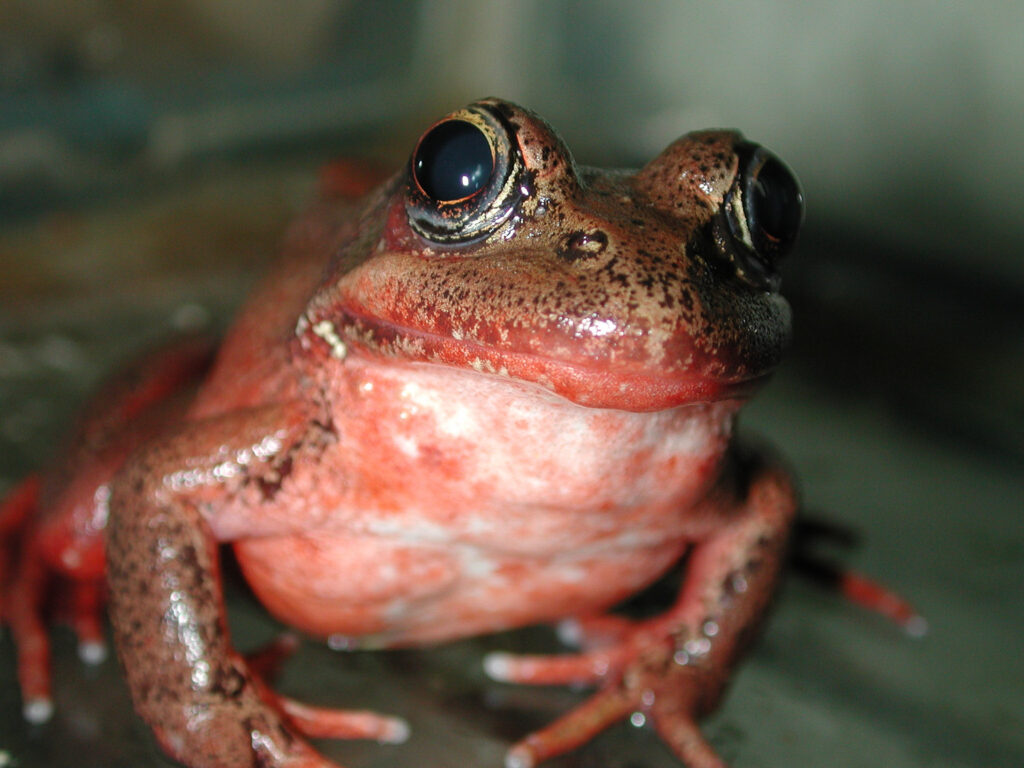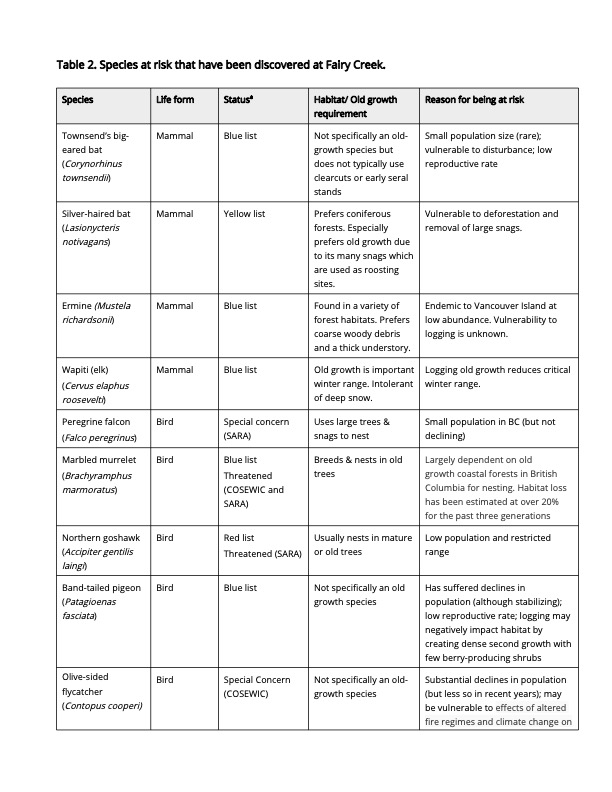Conservation of Unique and At-risk Species
Highlights
- Over 400 species of plants and animals rely on BC’s old growth forests for at least part of their life cycle. As of February 18, 2022, 326 species (plants, animals, birds, etc.) have been sighted and recorded in the Fairy Creek watershed, including 17 species that are at risk.
Many endangered species inhabit the old-growth forests that lie within and just outside of the Fairy Creek watershed. Eighty-two observations of 17 at-risk mammal, bird, amphibian and plant species have been recorded on iNaturalist as of February 18, 2022 (Table 2). Tasha Lavdovsky found the exceedingly rare, blue-listed oldgrowth specklebelly lichenLichens are complex organisms that arise from the symbiotic relationship between fungi and a photosynthetic partner, typically algae. There are three main types of lichens: foliose, fruticose, and crustose. Foliose lichens are a horizontally growing leafy type of lichen that is always attached to the surface where it is growing. A fruticose lichen is characterized by a coral -like shrubby or bushy growth structure, with upright (pendulous) branches. A crustoselichen is more like a flat crust on a surface or beneath the rock surface or trees. More (Pseudocyphellaria rainierensis) in a partially logged cut block at Fairy Creek. This lichenLichens are complex organisms that arise from the symbiotic relationship between fungi and a photosynthetic partner, typically algae. There are three main types of lichens: foliose, fruticose, and crustose. Foliose lichens are a horizontally growing leafy type of lichen that is always attached to the surface where it is growing. A fruticose lichen is characterized by a coral -like shrubby or bushy growth structure, with upright (pendulous) branches. A crustoselichen is more like a flat crust on a surface or beneath the rock surface or trees. More is unique to old growth forests on the west coast and the population at Fairy Creek is likely the largest ever found in BC. At risk bird species that retired University of British Columbia professor Dr. Royann Petrell and others have seen and heard in 2021 include marbled murrelets – sea birds that make solitary nests, only in old-growth forests – as well as western screech owls and others. The scientists’ biological survey also turned up endangered western toads, northern red-legged frogs, wandering salamanders, Townsend’s big-eared bat, and several at risk plant species.


In addition to the 17 at-risk species that have been observed in the Fairy Creek watershed (Table 2), many other red and blue listed plant species occur within the same or similar biogeoclimatic subzonesBiogeoclimatic subzones are the basic unit of climatic classification in British Columbia. Each subzone comprises a geographic area with a fairly uniform regional climate and a typical pattern of vegetation and soils. Subzones are grouped into biogeoclimatic zones to create more generalized units, and these are named after the climatic region and climatic climax plant community. More within the Alberni-Clayoquot Regional District located on west central Vancouver Island, where Fairy Creek is situated (Table 3). These species have not yet been discovered at Fairy Creek but many are likely there given that they occupy forest, riparian or other kinds of habitats that correspond to those found in old forests. Table 3 was compiled based on E-flora (Klinkenberg, 2020Klinkenberg, B. (ed.). 2020. E-flora BC: Electronic Atlas of the Plants of British Columbia [eflora.bc.ca]. Lab for Advanced Spatial analysis. Department of Geography, University of British Columbia, Vancouver. More), B.C. Species and Ecosystems Explorer, Conservation Data Center and the book Rare Native Vascular Plants of B.C. (Douglas et al., 1998Douglas, G., Straley, G.B., Meidinger, D.V. 1998, Rare native vascular plants of British Columbia. B.C. Min. Environ. Lands and Parks, Victoria, B.C. 423p. More).

Table 2: Species at risk that have been discovered at Fairy Creek
Click image to enlarge the table (PDF).

Table 3: Red and blue listed plant species likely but not confirmed to occur in the Fairy Creek watershed
Click image to enlarge the table (PDF).
